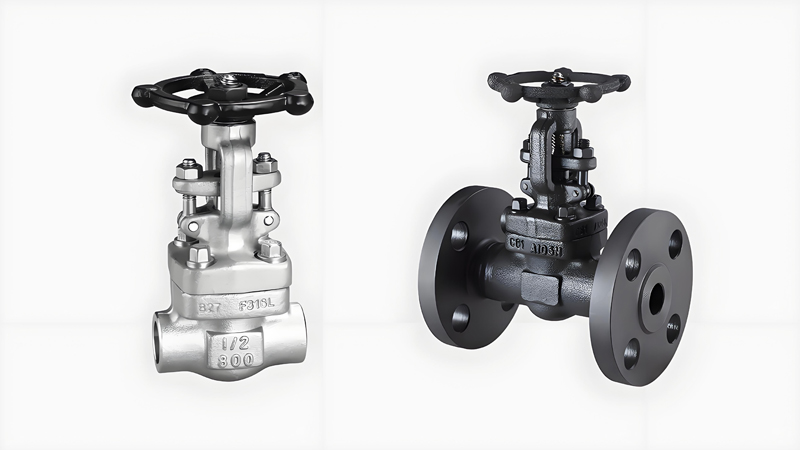Material Differences
Forged Steel:
Forged steel is produced by heating steel billets and shaping them under high pressure. This process enhances grain structure, resulting in superior mechanical strength, toughness, and resistance to high-pressure/temperature environments. Common grades include ASTM A105 (carbon steel) and ASTM A182 (stainless steel).
Cast Steel:
Cast steel is formed by pouring molten steel into molds. While cost-effective for complex shapes, it may exhibit porosity or inconsistencies, limiting its use in extreme conditions. Typical grades include ASTM A216 WCB (carbon steel) and ASTM A351 CF8M (stainless steel).

Key Differences Between Forged Steel Valve and Cast Steel Valves
| Parameter | Forged Steel Valves | Cast Steel Valves |
| Size Range | Smaller (DN15–DN200, ½”–8″) | Larger (DN50–DN1200, 2″–48″) |
| Pressure Rating | Higher (Class 800–4500) | Moderate (Class 150–600) |
| Temperature | -29°C to 550°C | -29°C to 425°C |
| Applications | High-pressure pipelines, refineries | Low/medium-pressure systems, water |
Valve Classifications
Forged Steel Valves
1. Forged Steel Gate Valves (Class 800): Compact design for high-pressure isolation in oil/gas systems.
2. Forged Steel Globe Valves: Precise flow control in steam or chemical services.
3. Forged Steel Check Valves: Prevent backflow in compressors or pumps (swing/lift types).
4. Forged Steel Ball Valves: Quick shut-off in Class 800 hydrocarbon pipelines.
Cast Steel Valves
1. Cast Steel Gate Valves (Class 150–300): Bulk fluid isolation in water treatment.
2. Cast Steel Globe Valves: General flow regulation in HVAC systems.
3. Cast Steel Check Valves: Low-cost solutions for non-critical services.
Why Choose Class 800 Forged Steel Valves
Class 800 forged steel valves withstand pressures up to 1380 bar (20,000 psi) at 38°C, making them ideal for:
- Offshore oil rigs
- High-temperature steam lines
- Hydrogen processing plants
Conclusion
Forged steel valves excel in high-stress environments due to their robust construction, while cast steel valves offer economical solutions for larger, low-pressure systems. Selecting the right type depends on operational requirements, budget, and industry standards like ASME B16.34.
Post time: Mar-07-2025

